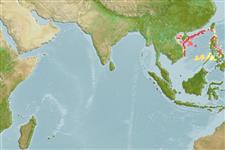Elasmobranchi (squali e razze) (sharks and rays) >
Orectolobiformes (Carpet sharks) >
Parascylliidae (Collared carpet sharks)
Etymology: Cirrhoscyllium: cirrus, Latin for curl or tendril, referring to barbels on throat; skylion, Greek for dogfish or small shark (See ETYFish); expolitum: Latin for varnished, referring to how the shark’s body, when dry, “glistens as though varnished, owing to the peculiar character of the dermal denticles” (See ETYFish).
More on authors: Smith & Radcliffe.
Environment: milieu / climate zone / distribuzione batimetrica / distribution range
Ecologia
marino demersale; distribuzione batimetrica 180 - 190 m (Ref. 43278). Deep-water; 23°N - 10°N, 105°E - 125°E
Western Pacific: South China Sea off China to the Philippines (Luzon). Gulf of Tonkin, Vietnam and Japan (off the Tanegashima Islands).
Size / Peso / Age
Maturità: Lm ? range ? - ? cm
Max length : 34.0 cm TL maschio/sesso non determinato; (Ref. 247)
Spine dorsali (totale) : 0; Spine anali: 0. Genus: pair of barbels on throat; color pattern of dark saddles, no light or dark spots (Ref. 43278).
Species: Six or possibly ten diffuse saddle marks on dorsal surface, saddles above abdomen rounded and continuing above pelvic-fin bases, not C-shaped, head length three times first dorsal-fin base (Ref. 43278). Gill region without collar marking (Ref. 13572).
Body shape (shape guide): elongated.
Found on the continental shelf, offshore on or near the bottom (Ref. 247). Food habits unknown (Ref. 13572). Oviparous (Ref. 43278, 50449). Interest to fisheries unknown (Ref. 13572). Probably taken as discarded by-catch of offshore trawl fisheries in the area (Ref. 43278).
Life cycle and mating behavior
Maturità | Riproduzione | Deposizione | Uova | Fecundity | Larve
Oviparous, paired eggs are laid. Embryos feed solely on yolk (Ref. 50449).
Compagno, L.J.V., 1984. FAO Species Catalogue. Vol. 4. Sharks of the world. An annotated and illustrated catalogue of shark species known to date. Part 1 - Hexanchiformes to Lamniformes. FAO Fish. Synop. 125(4/1):1-249. Rome, FAO. (Ref. 247)
IUCN Red List Status (Ref. 130435: Version 2025-1)
Threat to humans
Harmless
Human uses
Pesca: bycatch
Strumenti
Special reports
Download XML
Fonti Internet
Estimates based on models
Preferred temperature (Fonte Biblio.
123201): 8.5 - 21.9, mean 13.1 °C (based on 71 cells).
Phylogenetic diversity index (Fonte Biblio.
82804): PD
50 = 0.6289 [Uniqueness, from 0.5 = low to 2.0 = high].
Bayesian length-weight: a=0.00389 (0.00180 - 0.00842), b=3.12 (2.94 - 3.30), in cm total length, based on all LWR estimates for this body shape (Ref.
93245).
Trophic level (Fonte Biblio.
69278): 3.6 ±0.5 se; based on size and trophs of closest relatives
Resilienza (Fonte Biblio.
120179): Basso, tempo minimo di raddoppiamento della popolazione 4.5 - 14 anni (Fec assumed to be <100).
Fishing Vulnerability (Ref.
59153): Low vulnerability (24 of 100).
🛈
